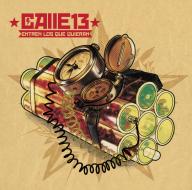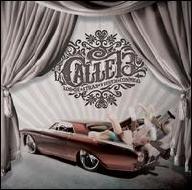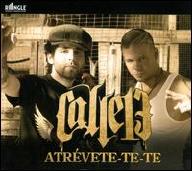Pérez and Cabra met at the tender age of two, when the former's mother married the latter's father. Their parents later divorced, but the step-brothers remained close. Their moniker, Calle 13 (meaning "13th Street"), along with their newly coined Residente and Visitante aliases, arose from their living situation: since Cabra visited his brother regularly at Pérez's residence (on 13th Street), rather than vice-versa, he was the "visitor," whereas Pérez was the "resident." Residente earned a master's degree in fine arts stateside, while Visitante studied music formally from age six. They began recording music together in 2004, with the idea of hosting their work on a website, beginning with two demos ("La Tripleta" and "La Aguacatona"). Within a year's time, however, they began shopping for a record label to release their music commercially. White Lion was a logical choice (it was the home of Tego Calderón, whom the two admired). Elias de León, the owner of White Lion, was forwarded the tape and realized immediately that there was something special about the music. He called Residente, who was working as an architectural draftsman at the time, and the two men met the following day.
White Lion signed Calle 13 soon afterward, and the label financed the duo's first video, for "Se Vale To-To," which Residente shot and edited himself with the help of his cousin at the cost of $14,000. Furthermore, de León hooked Residente up with established reggaeton vocalist Julio Voltio, who was also signed to White Lion, and the two collaborated on the song "Chulín Culín Chunlfy," which became a sizable hit. After generating some buzz on Puerto Rico radio with lead single "Se Vale To-To," White Lion released Calle 13 in November 2005. It did well, landing at number six on Billboard's Top Latin Albums chart; however, the sales were heavily Puerto Rican-based (the self-governing island is a U.S. commonwealth and therefore eligible for Soundscan computation) and subsequently languished until late summer 2006, when a second single, "¡Atrévete Te, Te!," began getting stateside airplay in Southern California. Another boost came when Nelly Furtado, concurrently riding high on the chart-topping success of "Promiscuous Girl," invited Residente to collaborate with her on a new version of "No Hay Igual" that would be released to Latino markets as a single and video.
The buzz continued to build month by month, partly fueled by the September 2006 announcement that the duo had netted three Latin Grammy nominations for Best New Artist, Best Short-Form Video, and Best Urban Album -- all of which were later won. In addition, there was the announcement of three nominations for MTV Latin America Awards; the duo was invited to perform with Furtado on the awards show, too. In fact, the Furtado affiliation proved quite fortuitous, as MTV also invited Calle 13 to accompany the pop singer for the world premiere of the new MTV Tr3s channel targeting Latinos and acculturated Americans in the age 13-25 demographic. Toward the end of 2006, the duo was the hottest new group in popular Latin music. Calle 13's year-old debut album had become a Top Ten success, as the pace of its sales grew week by week, and their videos were exceptionally popular Internet streams. All the while, Calle 13 continued to gain recognition in additional Latin markets such as Mexico and Spain.
Residente and Visitante released their second album, Residente o Visitante, in 2007. It garnered a good deal of attention, dethroning Jennifer Lopez from the number one spot on the Latin album chart. By this point, critics were well-attuned to the group, and on another front, MTV Tr3s supported Calle 13 passionately, continuously airing the video for lead single "Tango del Pecado," among other promotional spots. In effect, the release of Residente o Visitante became an event, one that was observed closely by many in the Latin music industry. Los de Atrás Vienen Conmigo followed closely behind, arriving in October 2008 and expanding the group's stylistic cache with elements of candombe and banda. Their 2010 effort, Entren los Que Quieran, found them collaborating with the experimental metal group the Mars Volta on its lead single "Calma Pueblo." The set was nominated for 11 Latin Grammy awards and took home nine, including prizes for Album of the Year, Best Urban Music album, Record of the Year, Song of the Year (both for the smash single "Latinoamérica," featuring Totó la Momposina, Susana Baca, and Maria Rita), and best Tropical Song ("Vamo' a Portarnos Mal").
Following extensive, sold-out tours of the Caribbean, the U.S., and Central and South America, Calle 13 went on an extended hiatus while its members pursued solo careers.
iLe was first out of the gate with 2016's iLevitable. Issued by Sony, the date was co-produced by the artist and Visitante and was mixed by Noah Georgeson. It peaked at number five on the Latin albums charts. That same year Residente appeared alongside K'naan, Snow Tha Product, and Riz MC on the smash single "Immigrants (We Get the Job Done)" in response to Donald Trump's presidential candidacy. Residente followed it with a self-titled debut album in 2017, and the adventurous long-player peaked at three on the Latin albums charts.
Visitante went down a studio rabbit hole for a few years, producing albums by his sister, Monsieur Periné, and La Vida Boheme. He won a 2017 Latin Grammy for Producer of the Year. In 2018 he issued Trending Topics in collaboration with songwriter/rapper Vicente Garcia. Its loosely linked songs probe the dominant ways in which technology interacts with reality in the 21st century culture, and often supplants it.
iLe struck again in 2019 with the full-length Almadura, a 12-song set co-produced with Calle 13 drummer Ismael Cancel. Deeply reliant on Latin American rhythms, it criss-crossed styles from bomba and plena to son and cumbia. The legendary pianist and composer Eddie Palmieri guested on two tracks: his classic "Mi Novia" and "Dejame Dicirte," which he co-wrote with iLe and Cancel.
In September 2021, Colombian reggaetonero and pop star J Balvin proposed a boycott of the Latin Grammys because of what he perceived as a lack of urban representation in award nominations. Residente quickly responded with a tweet accusing him of hypocrisy. In March 2022, he agitated Balvin further with a three-part, eight-minute diss track titled "Sesión 49" recorded in collaboration with Argentine producer DJ Bizarrap. The title of each section references Spanish novelist Miguel de Cervantes' 16th-century novel Don Quixote de la Mancha. Residente sees himself as a Don Quixote-esque figure who safeguards the historical integrity of urban Latin music, and Balvin as one of the genre's problems. Balvin accused the Colombian of many terrible things, including racism and misogyny, after an industry-deleted Balvin video single, "Perro."
In March 2022, Residente issued the polemic single "This Is Not America" with vocal assistance from Ibeyi. During interviews, Residente is consistently asked if Calle 13 has permanently split ; his firm response is "no," that they are still very much a group and are merely on hiatus. ~ Thom Jurek & Jason Birchmeier, Rovi


















